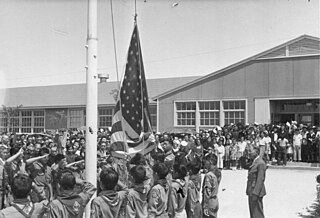
During the early years of World War II, Japanese Americans were forcibly relocated from their homes in the West Coast because military leaders and public opinion combined to fan unproven fears of sabotage. As the war progressed, many of the young Nisei, Japanese immigrants' children who were born with American citizenship, volunteered or were drafted to serve in the United States military. Japanese Americans served in all the branches of the United States Armed Forces, including the United States Merchant Marine. An estimated 33,000 Japanese Americans served in the U.S. military during World War II, of which 20,000 joined the Army. Approximately 800 were killed in action.

Anna is the largest community and retail trade center in Union County, Illinois, United States. Located in Southern Illinois, its population was 4,442 at the 2010 United States Census, a decline from 5,135 in 2000. It is known for being tied to its close neighbor Jonesboro, together known as Anna-Jonesboro. Anna is known for the Choate Mental Health and Development Center, a state facility that opened in 1869.

Rockford is a city in Winnebago County, Illinois, located in the far northern part of the state. Situated on the banks of the Rock River, Rockford is the county seat of Winnebago County. The largest city in Illinois outside of the Chicago metropolitan area, Rockford is the fourth-largest city in the state and the 171st most populous in the United States. According to 2020 U.S. Census data, the City of Rockford had a population of 148,655 with an outlying metropolitan area population of 348,360.
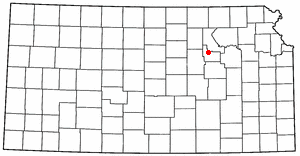
Fort Riley is a United States Army installation located in North Central Kansas, on the Kansas River, also known as the Kaw, between Junction City and Manhattan. The Fort Riley Military Reservation covers 101,733 acres (41,170 ha) in Geary and Riley counties. The portion of the fort that contains housing development is part of the Fort Riley census-designated place, with a residential population of 7,761 as of the 2010 census. The fort has a daytime population of nearly 25,000. The ZIP Code is 66442.

Fort Devens is a United States Army Reserve military installation in the towns of Ayer and Shirley, in Middlesex County and Harvard in Worcester County in the U.S. state of Massachusetts. It was named after jurist and Civil War general Charles Devens. The nearby Devens Reserve Forces Training Area is located in Lancaster. Although closed in 1996, the fort was reopened the next day as the Devens Reserve Forces Training Area. The name reverted to Fort Devens in May 2007.
Fort Sheridan is a residential neighborhood within the cities of Lake Forest, Highwood, and Highland Park in Lake County, Illinois, United States. It was originally established as Fort Sheridan, an Army post named after Civil War cavalry general Philip Sheridan, to honor his services to Chicago.

The 89th Infantry Division, originally known as the "89th Division," was an infantry formation of the United States Army that was active during World War I, World War II, and the Cold War.

The 86th Infantry Division was a unit of the United States Army in World War I and World War II. Currently called the 86th Training Division, based at Fort McCoy, Wisconsin, members of the division now work with Active Army, Reserve, and National Guard units to provide them with a Decisive Action Training Environment on a yearly basis.

The 31st Infantry Division ("Dixie") was an infantry division of the United States Army National Guard, active almost continuously from 1917 to 1968. Composed of men from Alabama, Florida, Georgia, Louisiana, Michigan, Illinois, and Mississippi at various points in its existence, the division saw service in both World War I and World War II, and was mobilized during the Korean War, although it was not sent overseas in the latter.

The 33rd Infantry Division was a formation of the U.S. Army National Guard between 1917 and 1968. Originally formed for service during World War I, the division fought along the Western Front during the Battle of Amiens, the Battle of Hamel, the Meuse-Argonne Offensive, at the Second Battle of the Somme, and at the Battle of Saint-Mihiel. It was re-formed during the inter-war period, and then later activated for service during World War II, seeing action against the Imperial Japanese Army in the Pacific. In the post war era, the division was reconstituted as an all-Illinois National Guard division. In the late 1960s, the division was reduced to a brigade-sized formation, and its lineage is currently perpetuated by the 33rd Infantry Brigade Combat Team.

The 28th Infantry Division ("Keystone") is a unit of the Army National Guard and is the oldest division-sized unit in the Department of Defense. Some of the units of the division can trace their lineage to Benjamin Franklin's battalion, The Pennsylvania Associators (1747–1777). The division was officially established in 1879 and was later redesignated as the 28th Division in 1917, after the entry of America into the First World War. It is today part of the Pennsylvania Army National Guard, Maryland Army National Guard, Ohio Army National Guard, and New Jersey Army National Guard.

The 85th Infantry Division also known as "Custer Division" was an infantry division of the United States Army in World War I and World War II. It currently exists as the 85th Support Command.

Chicago Rockford International Airport, is in Winnebago County, Illinois, United States, four miles (6 km) south of Rockford and 85 miles northwest of Chicago.
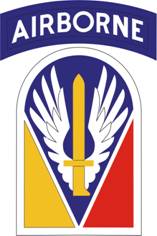
Fort Polk is a United States Army installation located in Vernon Parish, approximately ten miles (15 km) east of Leesville, Louisiana, and thirty miles (50 km) north of DeRidder in Beauregard Parish, Louisiana.
The 47th Infantry Regiment is an infantry regiment of the United States Army. Constituted in 1917 at Camp Syracuse, New York, the regiment fought in the Great War, and was later inactivated in 1921. Reactivated in 1940, the regiment fought during World War II in North Africa, Sicily, and Western Europe, then was inactivated in 1946. During the Cold War, the regiment saw multiple activations and inactivations, with service both in the Regular Army and the Army Reserve; it fought in Vietnam. Ultimately it was reactivated as a training regiment, and as of 1999, it has been assigned to Fort Benning and consists of two active battalions.

The 171st Infantry Brigade was an infantry brigade of the United States Army based at Fort Jackson, South Carolina. With a long history of serving, the brigade saw action during both World War I and World War II before it was inactivated in 1946. During the Cold War the brigade was once again activated for a period of ten years until again inactivated in 1972. In 2007 the brigade was reactivated as a training support unit and inactivated on 10 June 2016.
Camp Ellis was a United States World War II Army Service Forces Unit Training Center and prisoner-of-war camp between the towns of Bernadotte, Ipava, and Table Grove in Fulton County, Illinois. Construction began on 17 September 1942, and the camp opened on 16 April 1943, with an official dedication 14 July 1943. German prisoners of war were guarded by the 475th and 476th Military Police Escort Guard Companies. Training activities ended in November 1944.

The 129th Infantry Regiment is a United States military unit of the Illinois National Guard. The 129th served in World War I and World War II.
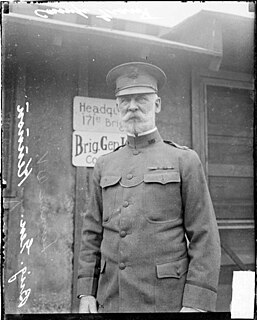
Lyman Walter Vere Kennon was a career United States military officer in active service from 1881 to 1918, attaining the rank of brigadier general. During the Spanish–American War Kennon was in command of Company "E" 6th Infantry Regiment and was cited for bravery at San Juan Hill. He was most recognized for his 1903–1905 work with the Corps of Engineers to lead the building of the Benguet Road, a mountain highway in the Philippines linking Rosario, La Union and the lowland areas to Baguio. During World War I, he commanded the military training facility at Camp Greene, North Carolina; the 171st Infantry, Brigade, Camp Grant, Illinois, and then the 86th Division, Camp Grant, Illinois.
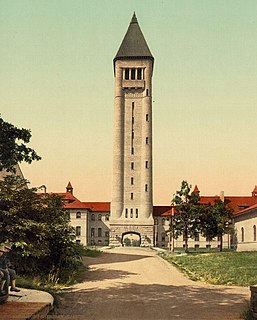
The Philip H. Sheridan Reserve Center is the former Fort Sheridan now in Lake Forest, Highwood, and Highland Park in Lake County, Illinois, United States. It was originally established as a United States Army Post named after Civil War Cavalry General Philip Sheridan, to honor his services to Chicago. When the main fort was officially closed by the Army on May 3, 1993, the majority of the property was sold by the Department of Defense to commercial land developers. Most of the original housing structures were then refurbished and resold as a residential community. Other buildings were given to cultural organizations like Midwest Young Artists, the largest youth music program in the Midwest. Approximately 90 acres (36 ha) of the southern end of the original post were retained by the Army; there the Army now operates the Sheridan Reserve Center complex.



















